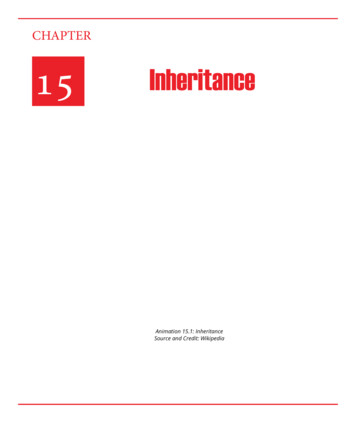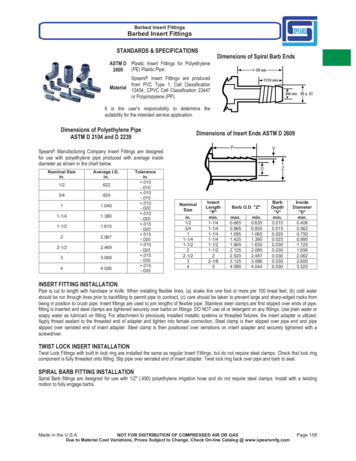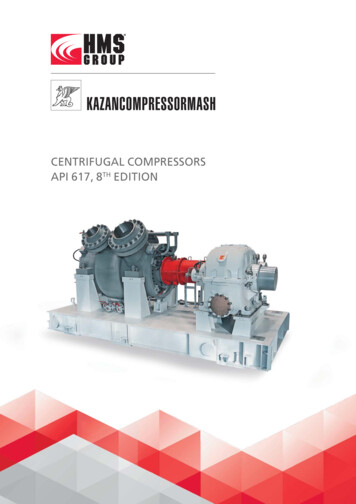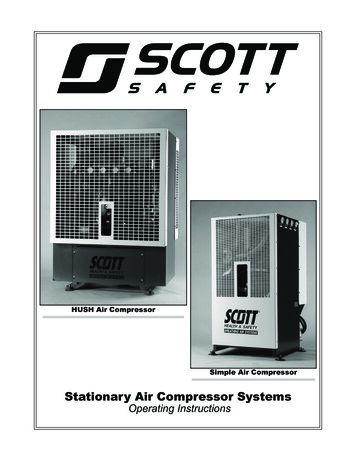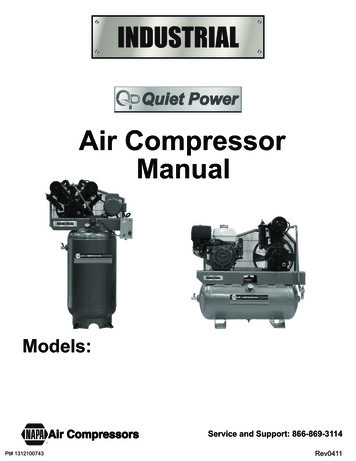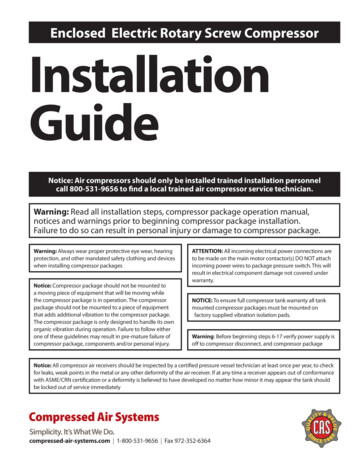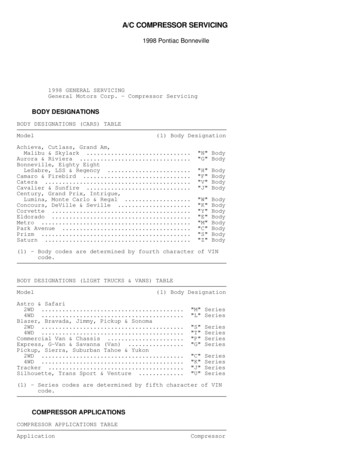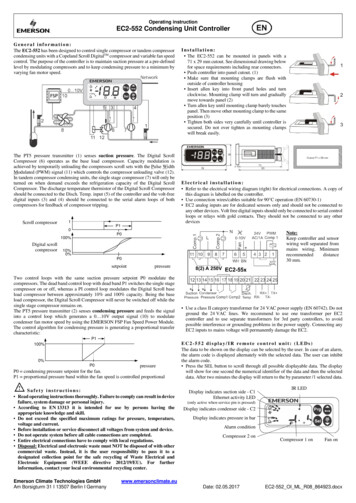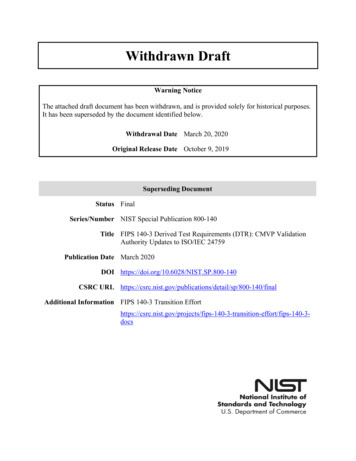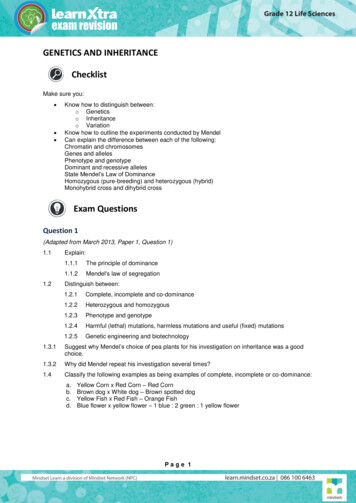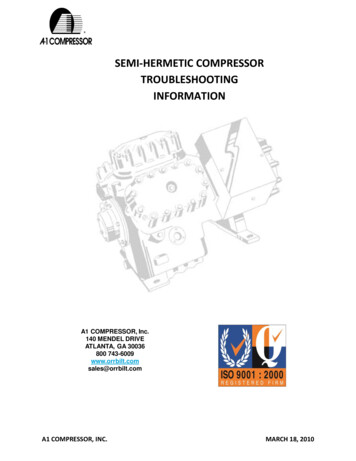
Transcription
SEMI-HERMETIC COMPRESSORTROUBLESHOOTINGINFORMATIONA1 COMPRESSOR, Inc.140 MENDEL DRIVEATLANTA, GA 30036800 743-6009www.orrbilt.comsales@orrbilt.comA1 COMPRESSOR, INC.MARCH 18, 2010
IDENTIFYING COMPRESSOR MECHANICAL FAILURESINDICATORS, SYMPTOMS & CORRECTIONSMost compressors fail due to system malfunction which must be corrected to prevent repeat failures.After a compressor fails, field examination of the failed compressor often will reveal symptoms ofsystem problems. Proper corrections will help eliminate future failures.REFRIGERANT FLOODBACKThis is a result of liquid returning to the compressor during the RUNNING CYCLE. The oil is dilutedwith refrigerant to the point it cannot properly lubricate the load bearing surfaces.Open Drive CompressorWorn pistons and cylinders.No evidence of overheating.Refrigerant Cooled CompressorsCenter & Rear bearing worn / seizedDragging rotor, shorted statorProgressively worn crankshaftWorn or broken rodsPossible worn piston ringsThe liquid washed the oil off the pistons andcylinder walls during the suction stroke causingthem to wear during the compression stroke.The liquid dilutes the oil in the crankcase and therefrigerant rich oil will be pumped to the rodsand bearings through the crankshaft. As therefrigerant boils off, there will not be enough oilfor proper lubrication at the bearing farthestfrom the oil pump. The center and rear bearingsmay seize or may wear enough to allow the rotorto drop and drag on the stator causing it to shortor spot burn.CORRECTION:1. Maintain proper evaporator and compressor superheat.2. Correct abnormally low load condition.3. Install suction accumulator to stop uncontrolled liquid returnFLOODED STARTSWorn or scored rods or bearingsRods broken from seizureErratic Wear pattern or crankshaftThis is the result of refrigerant migration to thecrankcase oil during the OFF CYCLE. When thecompressor starts, the diluted oil cannot properlylubricate the crankshaft load bearing surfacescausing erratic wear or seizure pattern.CORRECTION:1. Locate the compressor in a warm ambient or install continuous pumpdown.2. Check crankcase heater operation ( Should be energized during off cycle).3. Operate with minimum refrigerant charge.A1 COMPRESSOR, INC.MARCH 18, 2010
IDENTIFYING COMPRESSOR MECHANICAL FAILURESINDICATORS, SYMPTOMS & CORRECTIONSLIQUID SLUGGINGBroken reeds, rods or bearings.Loose or broken backer rodsBlown GasketsThis is the result of trying to compress liquid in thecylinders. Slugging is an extreme floodback in thefirst stage of compound or in open drivecompressors and a severe flooded start in thesecond stage of compound or in refrigerant cooledcompressors.CORRECTION:1. Maintain proper evaporator and compressor superheat.2. Correct abnormally low load conditions3. Locate the compressor in a warm ambient or install continuous pumpdown4. Proper oil management piping sized properly.HIGH DISCHARGE TEMPERATUREDiscolored valve plateBurned reed valvesWorn pistons, rings and cylindersStator spot burn from metal fragmentsThis is the result of temperatures in thecompressor head and cylinders becoming so hotthat the oil loses its ability to lubricate properly.That causes pistons, rings and cylinder walls towear resulting in blow by, leaking valves and metalfragments in the oil.CORRECTION:1. Correct high compressor ration from low load conditions, high discharge pressureconditions.2. Check low pressure switch setting.3. Insulate suction lines.4. Provide proper compressor cooling motor cooling. Excessive motor heat can overheatrefrigeration.LOSS OF OILAll rods and bearings worn or scoredCrankshaft uniformly scored.Rods broken from seizureLittle or no oil in crankcaseThis is the result of insufficient oin in thecrankcase to properly lubricate the bearingsurfaces. When the flow of refrigerant is too lowto return oil as fast as it is being pumped out, auniform wearing of all load bearings will result.CORRECTION:1. Check Oil failure control operation, if applicable.2. Check system refrigerant charge.3. Correct abnormally low load situations or short cycling.4. Check for improper line sizing and improper traps.5. Check for inadequate defrosts.A1 COMPRESSOR, INC.MARCH 18, 2010
IDENTIFYING COMPRESSOR MECHANICAL FAILURESINDICATORS, SYMPTOMS & CORRECTIONSELECTRICAL FAILURESMotors are generally damaged as a result of mechanical failures but some are true electricalfailures.GENERAL OR UNIFORM BURNEntire motor winding is uniformly overheatedor burnedSINGLE PHASE BURNA result of not having current through the unburned and overloading of the other two.CORRECTION:1. Check for high or low voltage.2. Check for unbalanced voltage3. Check for rapid compressor cyclingTwo phases of a three phase motor areoverheated or burned.CORRECTION:1. Check For proper motor protection.2. Check contactor contacts and mechanical condition.3. Check terminal and wiring condition.4. Check for unbalanced voltage.5. Check for blown fuses.HALF WINDING SINGLE PHASE BURNThis occurs when one half of a PART WINDING START motor has a single phasing condition. Twocontactors are used in the PART WINDING START and a problem exists with one.CORRECTION:1. Check both contactors, one will be defective.2. Check sequence timer for one second or less total time.HALF WINDING BURNHalf of all phases are PART WINDING START motor is overheated or burned.CORRECTION:1. Check for electrical feed back circuit energizing a contactor holding coil.2. Replace contactors with ones properly sized.A1 COMPRESSOR, INC.MARCH 18, 2010
IDENTIFYING COMPRESSOR MECHANICAL FAILURESINDICATORS, SYMPTOMS & CORRECTIONSELECTRICAL FAILURESPRIMARY SINGLE PHASE BURNOnly one phase of a three phase motor is overheated or burned as the result of the loss of a phase ofthe primary of ato Y or Y totransformer configuration.CORRECTION:1. Check transformer for proper voltage incoming and outgoing.START WINDING BURNOnly the start winding is burned in a single phase motor due to excessive current in the start winding.CORRECTION:1. Check C, S and R wiring of the compressor.2. Check start capacitor and start relay.3. Check for overloaded compressor.RUN WINDING BURN:Only the run winding is burned in a single phase compressor.CORRECTION:1. Check start relay.2. Check run capacitor.3. Check supply voltage.SPOT BURNA localized burn within the winding, between the winding, or from winding to ground. Can beelectrical failure or possible mechanical failure resulting from foreign materials in motor winding.A1 COMPRESSOR, INC.MARCH 18, 2010
TROUBLESHOOTING CHECK LISTCOMPRESSOR CONDITIONCOMPRESSOR HUMS BUT WON’TSTARTCOMPRESSOR WILL NOT RUN,DOES NOT TRY TO STARTCOMPRESSOR STARTS BUT TRIPSON OVERLOAD PROTECTORUNIT SHORT CYCLESSTARTTING RELAY BURNS OUTCONTACTORS STICK ON STARTINGRELAYSTARTING CAPACITORS BURN OUTA1 COMPRESSOR, INC.POSSIBLE CAUSE1. Improperly wired.2. Low line voltage.3. Defective start relay.4. Defective run or start capacitor.5. Un-equalized pressures on PSC motor.6. Shorted or grounded motor windings.7. Internal compressor mechanical damage.1. Power circuit open due to blown fuse, tripped circuitbreaker, or open disconnect switch.2. Compressor motor protector open.3. Open thermostat or control.4. Burned motor windings – open circuit.1. Low line voltage.2. Improperly wired.3. Defective run or start capacitor.4. Defective start relay.5. Excessive suction or discharge pressure.6. Tight bearings or mechanical damage in compressor.7. Defective overload protector.8. Shorted or grounded motor windings.1. Control differential too small.2. Shortage of refrigerant.3. Discharge pressure too high.4. Discharge valve leaking.1. Low or high lie voltage.2. Short cycling.3. Improper mounting of relay.4. Incorrect running capacitor.5. Incorrect relay.1. Short running cycle.2. No bleed resistor on start capacitor.1. Compressor short cycling.2. Relay contacts sticking.3. Incorrect capacitor.4. Start winding remaining in circuit for prolongedperiod.MARCH 18, 2010
TROUBLESHOOTING CHARTOBSERVATIONPOSSSIBLE CAUSEPower Off1. COMPRESSOR WILLNOT START2. LOW COMPRESORCAPACITY ORINABILITY TO PULLDOWN SYSTEMCurrent overloadOil safety switch openLoose electrical connectionsor faulty wiring.Compressor motor burnedout.Blown valve plate or cylinderhead gasket.Leaky valve plate or wornvalve seats.Leaky suction valvesBroken connecting rods orpistonsCylinder head bolts notproperly torque3. BLOWN VALVE PLATEA1 COMPRESSOR, INC.REMEDYCheck main switch, fuses andwiring.Reset manuallyReset manuallyTighten connections. Checkwiring and rewire ifnecessary.Check and replacecompressor, if necessary.See No. 3Replace valve plate assemblyPump down, remove cylinderhead, examine valves andvalve seats. Replace, ifnecessary.Replace Compressora. Replace gaskets.b. Re-torque cylinder headbolts to manufacturers specs.Excessive oil in compressorsystems causes hydrauliccylinder pressures.a. Remove excessive oil untiloil level is maintainedbetween 1/8 – 3/8 up thesight glass.Liquid refrigerant floodbackor flooded startSee No. 7 ( Flooding)MARCH 18, 2010
TROUBLESHOOTING CHARTOBSERVATIONPOSSSIBLE CAUSELow pressure switch erratic inoperation4. COMPRESSORCYCLESINTERMITTENTLY5. COMPRESSORCONTINUOUSLYCYCLES6. LOW DISCHARGEPRESSUREInsufficient refrigerant in system.Suction service valve closed.Suction service valve closed.Insufficient water flowingthrough condenser or cloggedcondenser.Discharge service valve not fullyopen.Air in systemCondenser capacity reduced byrefrigerant over-chargeaccompanied by high dischargepressure.Plugged filter-drier.Excessive water flow throughcondenserSuction service valve partiallyclosed.Leaky compressor suction valves.Worn piston ringsA1 COMPRESSOR, INC.REMEDYa. Check tubing to switch tosee if clogged or crimped.b. Check setting of switch.Add refrigerant.Open Valve.Adjust water regulating valveto condenser,Clean condenser.Open ValvePurgeRepair or ReplaceCheck and clean tubingRemove excess refrigerantReplace filterAdjust water regulating valveOpen valvePump down, remove thecylinder head, examinevalves and valve seats;replace if necessary.Replace compressorMARCH 18, 2010
TROUBLESHOOTING CHARTOBSERVATIONPOSSSIBLE CAUSEImproper system pipingslows liquid to compressorDefrost cycle improperly setor not operating correctly7. FLOODINGDefective or improperly setexpansion valveEvaporator fan failure8. LOW PRESSURESUCTIONInsufficient refrigerantEvaporator fan failurePlugged filter-drierSlugging due to floodback ofrefrigerant.Hydraulic knock due toexcess oil in circulationBearings wiped because ofloss of oil.REMEDYCorrect piping.Do not allow more than 1/3of system on defrost at anygiven time. Check operationof defrost system.Increase superheat or replacevalveCorrect problem or replacefanAdd refrigerantCorrect problem or replacefan.Replace filterSee No. 7 ( Flooding)a. Remove excess oilb. Recheck oil return system.a. Add oilb. Check oil return system.c. See No. 15 ( Oil Return) &No. 11 ( Oil Pressure)d. Check for defective oilfailure control.9. COMPRESSOR NOISYImproper support or isolation Provide sufficient right angleof pipingbends in piping to absorbvibration and support firmlywith suitable hangers.Compressor not firmlyCheck for loose mounts.mountedUnit not properly isolated or Add vibration isolation orvibration pad defective,check for defective isolationpads.Broken connecting rods,Replace compressor.valves or other running gear.A1 COMPRESSOR, INC.MARCH 18, 2010
TROUBLESHOOTING CHARTOBSERVATION10. PIPE RATTLE11. OIL PRESSURE LOWERTHAN NORMAL ORNO OIL PRESSUREPOSSSIBLE CAUSEREMEDYInadequate supported pipingor other running gearLow oil chargeFaulty oil pump drivesegmentWorn oil pumpSupport pipes or check pipeconnections.Check oil lever requirementsReplace segmentReplace bearing headassemblyWorn compressor bearingsReplace compressorHigh suction pressure on low If system does not have EPRtemperature compressorvalve, throttle suction servicecauses excessive amp drawvalve until system pullsdown.High discharge pressureCheck for loss of condenserwater or blocked condenserfan or coil.Incorrect overload relay orReplace with correctmust trip amp setting too low overload relay.12. COMPRESSOR MOTORDefective overload relayReplacePROTECTORSHigh suction temperatureReduce suction temperatureTRIPPING OR CYCLINGby TXV adjustment orprovide de-superheating.Loose power or controlCheck all power and controlcircuit wiring connectioncircuit connections.Defective motorCheck for motor ground orshort. Replace compressor iffound.Faulty motor protectionReplace module or headdevicesensor, if necessary.A1 COMPRESSOR, INC.MARCH 18, 2010
TROUBLESHOOTING CHARTOBSERVATIONPOSSSIBLE CAUSELow line voltageSeized compressor (removebearing head assembly andattempt to rotate crankshaft)Compressor motor defective13. COMPRESSOR CYCLESON LOCKED ROTOR14. MOTOR BURNOUTA1 COMPRESSOR, INC.Single phasingLiquid refrigerant condensingin the cylinderOn part-winding startcompressors, the second setof windings may not beenergized.Check control box for weldedstarter contacts, weldedoverload contacts or burnedout heater elements.REMEDYCheck line voltage anddetermine location of voltagedrop.Replace compressorCheck for motor windingshort or ground.Check voltage across all 3 legsat contactor. Correct sourceof problem.Check and replace valveplatesa. Faulty contactor – replace.b. Faulty time-delay relay –replace.Replace defectivecomponentsMARCH 18, 2010
TROUBLESHOOTING CHARTOBSERVATION15. CARRIERCOMPRESSORS ONPARALLELCOMPRESSORINSTALLATIONS, OILLEVEL DOES NOTEQUALIZE OR REMAINAT A CONSTANT LEVELIN ALL COMPRESSORSA1 COMPRESSOR, INC.POSSSIBLE CAUSEOil equalization line not levelpreventing gas equalization.06E Compressors only:Pressure equalization checkvalve in the motor rotor lockbolt may have been left outin one or all compressorsExcessive blow by intocrankcase – worn rings,valves or blown gasket.06D Compressors Only:Oil pressure regulator tube isnot below sight glass openingand is discharging oil into theoil equalization line and intoan off compressor. (Tube hasbeen replaced by Valve Ass’y.on newer models)REMEDYLevel oil equalization line.Remove suction service valveand inspect for check valve In motor rotor lock bolt at theend of the crankshaft. Checkvalve is required on al m) Ecompressors in parallelsystems using oil equalizationline connected at the sightglass location.Replace gasket, valve plate orcompressor.On 06D parallel compressorsystems, remove oilequalization line and insureoil regulator tube is belowopening. Push down ifnecessary.MARCH 18, 2010
TROUBLESHOOTING CHARTOBSERVATIONPOSSIBLE CAUSEBlown valve plate or cylindergasketBroken suction or dischargevalveCompressor ratio too high16. COMPRESSORRUNNING HOTA1 COMPRESSOR, INC.REMEDYSee No. 3Replace valves and valveplate, if necessary.a. Check setting of high andlow pressure switchesb. Check condenser – is itplugged?c. Check that all evaporatorand condenser fans areoperating properly.High Suction TemperatureReplace suction temperatureby TXV adjustment orprovide de-superheating.Cylinder head cooling fan not Replace defective part oroperating or incorrect voltage check that available voltageto fan motoragrees with fan motorvoltage.Non-seating internal pressure Inspect for signs ofrelief valve.overheating, replace ifnecessary.High oil levelLower oil level.Excessive blow-by-intoReplace gasket, valve plate orcrankcase – worn rings,compressor.valves or blown gasketMARCH 18, 2010
A1 COMPRESSOR, INC. MARCH 18, 2010 IDENTIFYING COMPRESSOR MECHANICAL FAILURES INDICATORS, SYMPTOMS & CORRECTIONS LIQUID SLUGGING Broken reeds, rods or bearings. Loose or broken backer rods Blown Gaskets This is the result of trying to compress liquid in the cylinders. Slugging is an extreme floodback in the first stage of compound or in open drive
